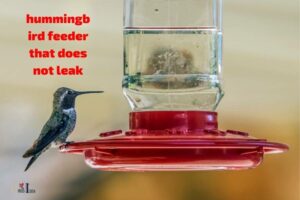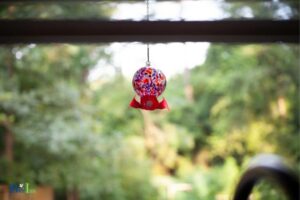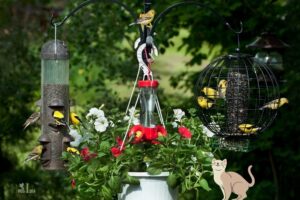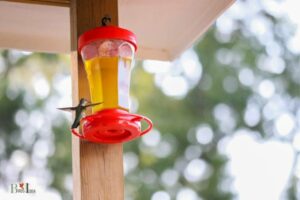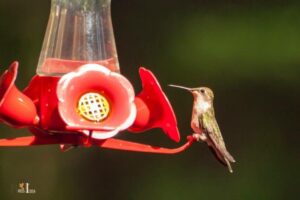Does Rain Dilute Hummingbird Feeders: Yes!
Yes, rain can dilute the nectar in hummingbird feeders, affecting the sugar concentration and potentially making it less appealing to hummingbirds.
Hummingbird feeders typically contain a sugar solution that mimics the nectar found in flowers.
The ideal sugar concentration for hummingbird nectar is about 20-30%. When it rains, water can enter the feeder through the feeding ports and mix with the sugar solution, causing the concentration to drop.
As a result, the nectar becomes less appealing to hummingbirds, as they prefer higher sugar concentrations to meet their energy needs.
To minimize the effects of rain on your hummingbird feeder, you can take several precautions.
First, choose a feeder with a built-in dome or roof to shield it from rain. Second, place the feeder under a larger overhang or in a sheltered spot to provide additional protection.
Finally, you can regularly inspect and replace the nectar in your feeder to ensure it remains concentrated and fresh, providing an optimal food source for the hummingbirds visiting your yard.
5 Factors: About Rain Dilute Hummingbird Feeders
| Factor | How Rain Dilutes Hummingbird Feeders | How to Prevent Dilution |
| Rain intensity | Heavy rain can splash into the feeder, introducing more water and diluting the nectar concentration. | Place the feeder under a shelter or awning to protect it from direct rainfall. |
| Feeder design | Open feeders without protective covers are more susceptible to rain dilution. | Choose a feeder with a built-in rain guard or add one to your existing feeder. |
| Feeder position | If the feeder is placed in an exposed location, wind can drive rain into the nectar. | Position the feeder in a sheltered location away from the direct impact of wind and rain. |
| Rain duration | Prolonged rainfall can lead to more dilution of the nectar. | Regularly monitor the feeder and replace the nectar after significant rainfall. |
| Nectar ratio | A feeder with a lower sugar-to-water ratio is more susceptible to dilution. | Use a ratio of 4:1 water to sugar for hummingbird nectar to maintain the optimal concentration even if some dilution occurs. |
Key Takeaway
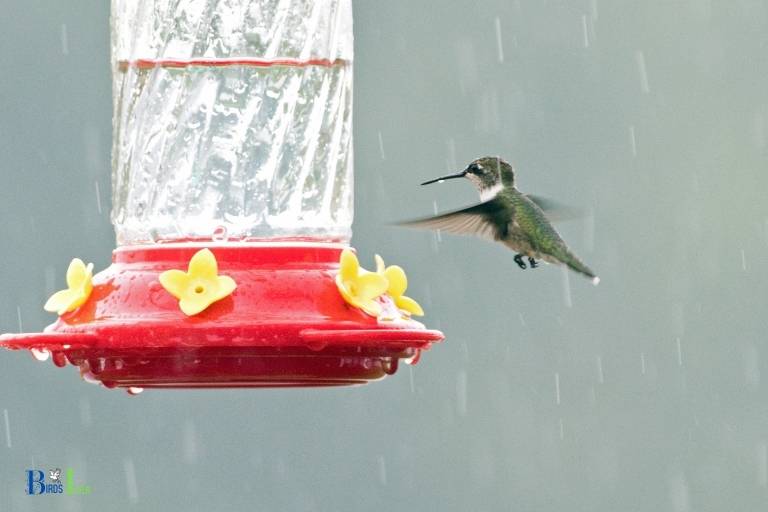
Five Facts About: Rain Dilute Hummingbird Feeders
How Rain Impacts Hummingbird Feeders
Hummingbirds are fascinating creatures to watch, and providing them with nectar through feeders can be highly rewarding. However, if you live in an area with frequent rain, you may be wondering how it affects your hummingbird feeders.
In this blog post, we will explore the effect of rain on the nectar solution and the potential damage it can cause to feeder components.
Discuss The Effect Of Rain On The Nectar Solution
Rain can significantly impact the quality of the nectar solution in your hummingbird feeder, making it less nutritious for our feathered friends.
Here are some things to keep in mind:
- Dilution: As soon as rainwater enters the feeder, it dilutes the sugar concentration, which can make the nectar less attractive to hummingbirds, leading them to look for food elsewhere.
- Microbial growth: Dilution also creates an environment that is conducive to microbial growth, which can cause bacteria, yeast, and other microorganisms to thrive. This can spoil the nectar solution and lead to fermentation or souring, which can harm hummingbirds’ health if they consume contaminated food.
- Spoilage: In addition to microbial growth, rainwater can also cause mold and spoilage, which can turn the nectar solution into a sticky mess that clogs the feeder and makes it unhygienic.
To ensure the quality of your nectar solution, it’s a good idea to monitor it regularly and refresh it every few days or when it becomes cloudy or discolored.
If you’re experiencing heavy rainfall in your area, it’s best to remove the feeder until the rain stops.
Highlight The Potential Damage To The Feeder Components
Although hummingbird feeders are made to withstand outdoor conditions, heavy rain can cause potential damage to feeder components like:
- Leaks and cracks: Moisture from heavy rainfall can seep through any small crack or weak spot in the feeder and cause it to leak. Besides, exposure to moisture and uv rays can make plastic, glass, or metal components brittle and prone to cracking or breaking, leading to water spills and the nectar solution seeping out and attracting ants and other insects.
- Corrosion: Feeders with metal components like hangers or perches can corrode when exposed to rain and moisture, leading to rust and weakening the structural integrity of the feeder, which could cause it to fail or collapse.
- Mold and mildew: Wet and unclean feeder parts can harbor mold and mildew growth, creating poor hygiene conditions for hummingbirds and damaging the feeder’s appearance over time.
Regular cleaning, drying, and maintenance of your feeder can help prevent damage and ensure its longevity. It’s also essential to invest in a high-quality feeder with sturdy and durable components designed to withstand harsh weather conditions.
While rain can provide a refreshing drink for hummingbirds in their natural habitat, it’s crucial to take precautions and protect your feeder from its harmful effects.
By keeping an eye on the nectar solution’s quality and maintaining the feeder’s components, you can provide a safe and welcoming environment for hummingbirds to enjoy.
The Role Of Sugar In Hummingbird Feeders
Hummingbirds are delicate and beautiful creatures, and watching them sip nectar from feeders is a great way to enjoy their company.
However, have you ever wondered if rain can dilute hummingbird feeders and affect the health of these adorable birds?
Explain The Role Of Sugar Concentration In The Nectar Solution:
The nectar solution in hummingbird feeders is composed of water and sugar. The role of sugar in the nectar solution is to provide the birds with a sweet, energy-rich food source.
The concentration of sugar in the nectar solution is essential for hummingbirds’ health and well-being.
Discuss How Rainwater May Dilute The Sugar Concentration Of The Nectar Solution:
Hummingbird feeders are often hung outside and are exposed to the elements, which can include rain. When rainwater enters the feeder, it can dilute the sugar concentration of the nectar solution inside.
This dilution can occur due to the following reasons:
- The rainwater mixes with the nectar solution inside the feeder, reducing the sugar concentration.
- As the water evaporates, the sugar concentration will rise, but if too much water enters the feeder, the sugar concentration may not rise sufficiently.
- Prolonged rain can cause the sugar solution to ferment, which can harm the birds.
To ensure the hummingbird feeders’ contents maintain healthy sugar concentrations, responsible pet owners must take care when filling up the feeders after a rain shower. They can replace the nectar solution if the mix is too diluted or expired.
In cases of heavy rain, it is best to take the feeder indoors to prevent bacterial growth and to protect the food source from becoming moldy.
Rainwater can dilute the sugar concentration of the nectar solution in hummingbird feeders, but responsible pet owners can prevent this from happening.
By taking proper care of the hummingbird feeders, they can enjoy watching these lovely birds and support their healthy lifestyles.
Preventing Rainwater Contamination In Hummingbird Feeders
Hummingbirds are absolutely fascinating! These little creatures certainly bring delight wherever they go. As a backyard birding enthusiast, you’ve probably set up a hummingbird feeder to bring these winged beauties closer to your home.
However, you may often wonder – does rain dilute hummingbird feeders?
If you’re not aware of the best practices to maintain hummingbird feeders during rain, your feeder could quickly become a breeding ground for bacteria, mold, and other harmful contaminants.
Read on to explore the best practices to keep hummingbird feeders dry and uncontaminated during rain.
Discuss The Best Practices For Keeping Hummingbird Feeders Dry During Rain
Hummingbirds provide an excellent source of entertainment, and it’s essential to keep their feeders in great condition, especially during rainy seasons.
Here are the best practices to keep hummingbird feeders dry during rain:
- Place the feeder beneath the eaves: Place your hummingbird feeder in the covered area where it won’t get wet, such as under the eaves of your house or beneath a shed or tree canopy.
- Waterproof the feeder: Instead of keeping the feeder out in the rain, consider purchasing a waterproof hummingbird feeder. There are many options available in the market that you can choose from.
- Use an umbrella or rain guard: Cover your feeder with an umbrella or rain guard. This will create a dry area for the hummingbirds to feed while keeping the nectar dry.
Explain How To Properly Clean And Maintain Hummingbird Feeders To Prevent Contamination After Rain
Hummingbird feeders should be cleaned regularly, especially during rainy seasons. You need to be careful not to contaminate the nectar when cleaning.
Here’s a step-by-step guide on how to clean and maintain hummingbird feeders after rain:
- Remove any remaining nectar from the feeder: Empty the nectar out of the feeder and dispose of it properly. Use a soft-bristled brush or sponge to clean the inside of the feeder thoroughly.
- Use hot water to rinse the feeder: Rinse the feeder with hot water to remove any leftover nectar or debris.
- Soak the feeder in a solution of vinegar and water: Create a solution of one part white vinegar and four parts water. Soak the feeder in this solution for about an hour.
- Scrub the feeder thoroughly: After soaking, scrub the feeder inside and out using a soft brush or sponge. Pay close attention to the feeding ports and any hard-to-reach areas.
- Rinse the feeder with hot water: Rinse the feeder with hot water again to ensure all the vinegar solution is removed.
- Dry the feeder completely: Dry the feeder thoroughly with a soft cloth or paper towel. You can also leave it out in the sun to dry completely before refilling it with nectar.
By following these practices, you can keep your hummingbird feeders dry and uncontaminated. Your feathered friends will thrive and continue to bring joy to your backyard birding experience.
Signs Of Rain-Diluted Nectar Solution In Hummingbird Feeders
Hummingbirds are fascinating little creatures that bring us joy with their buzzing and hovering. To attract them to our backyards, many of us put up hummingbird feeders.
These feeders are filled with nectar solution that mimics the flowers that hummingbirds feed on, but it is important to note that rainwater can contaminate the solution and dilute its potency.
Here are the signs that you should look out for to identify rainwater contamination:
- Cloudy nectar solution: If you notice that the nectar solution in your hummingbird feeder is cloudy, it is likely that it has been contaminated by rainwater.
- Fermented smell: When the nectar solution goes bad, it will start to smell sour like fermented liquid. The smell is usually a sign that yeast and bacteria have started to grow in the solution.
- Mold growth: In addition to the smell, you may notice mold growth in the nectar solution. The mold can appear as a slimy film on the surface of the liquid.
Identify The Potential Signs Of Rainwater Contamination In Hummingbird Feeders
Keeping your hummingbird feeder clean is important to ensure the nectar solution inside is of high quality.
You can prevent rainwater contamination by being aware of these signs:
- Positioning of the feeder: If the feeder is placed under a tree, near a sprinkler, or in an area where rainwater can easily get inside, it increases the chances of rain contamination.
- Leakage in the feeder: Hummingbird feeders with cracks and leaks make it easier for rainwater to seep inside.
- Age of the nectar: Old nectar solution can easily get contaminated with rainwater and other debris.
Discuss Ways To Address And Fix The Issue Of Rainwater Contamination
If you identify any of the signs of rainwater contamination in your hummingbird feeder, take immediate action to address and fix the problem.
Here are some ways to fix it:
- Clean the feeder: Remove any remaining nectar solution inside the feeder and clean it thoroughly with hot water and mild soap. Rinse it properly to ensure no soapy residue is left.
- Change the nectar: If the nectar solution is old or shows signs of contamination, this is the time to discard it and make a fresh one from scratch.
- Cover the feeder: To prevent rainwater from getting inside the feeder, you can use a rain guard. This will protect the nectar solution from dilution and keep it fresh for the hummingbirds.
- Place the feeder in the right location: To prevent rainwater contamination, it is important to place the feeder in an area where it is exposed to sunlight and with no sprinklers nearby.
Rainwater contamination can be a problem for hummingbird feeders, but with proper care and attention, it can be addressed and fixed. Keep your feeder clean, change the nectar solution regularly, use a rain guard, and place the feeder in the right location.
By following these simple steps, you can attract hummingbirds to your backyard and enjoy their presence all season long.
FAQ Of Does Rain Dilute Hummingbird Feeders
Does Rain Affect Hummingbird Feeders?
Do Hummingbirds Still Feed In The Rain?
How Can I Protect My Hummingbird Feeder From The Rain?
Will Diluted Nectar Harm Hummingbirds?
Conclusion
As we have concluded, rainwater does dilute hummingbird feeders, making the nectar less enticing for hummingbirds. It is essential to cover the feeder or bring it inside during rainy days and replace the nectar more frequently during the rainy season.
Diluted nectar can also spoil quickly and reduce the chances of hummingbirds visiting your feeder.
The best way to keep the feeder in good condition is to clean it with a solution of one-part vinegar and four parts water every time you refill the nectar.
It is crucial to providing an adequate, desirable source of nectar to help hummingbirds survive during migration.
By following these steps, you can ensure that your hummingbird feeder remains a lively destination for the tiny feathered visitors during their migration.

